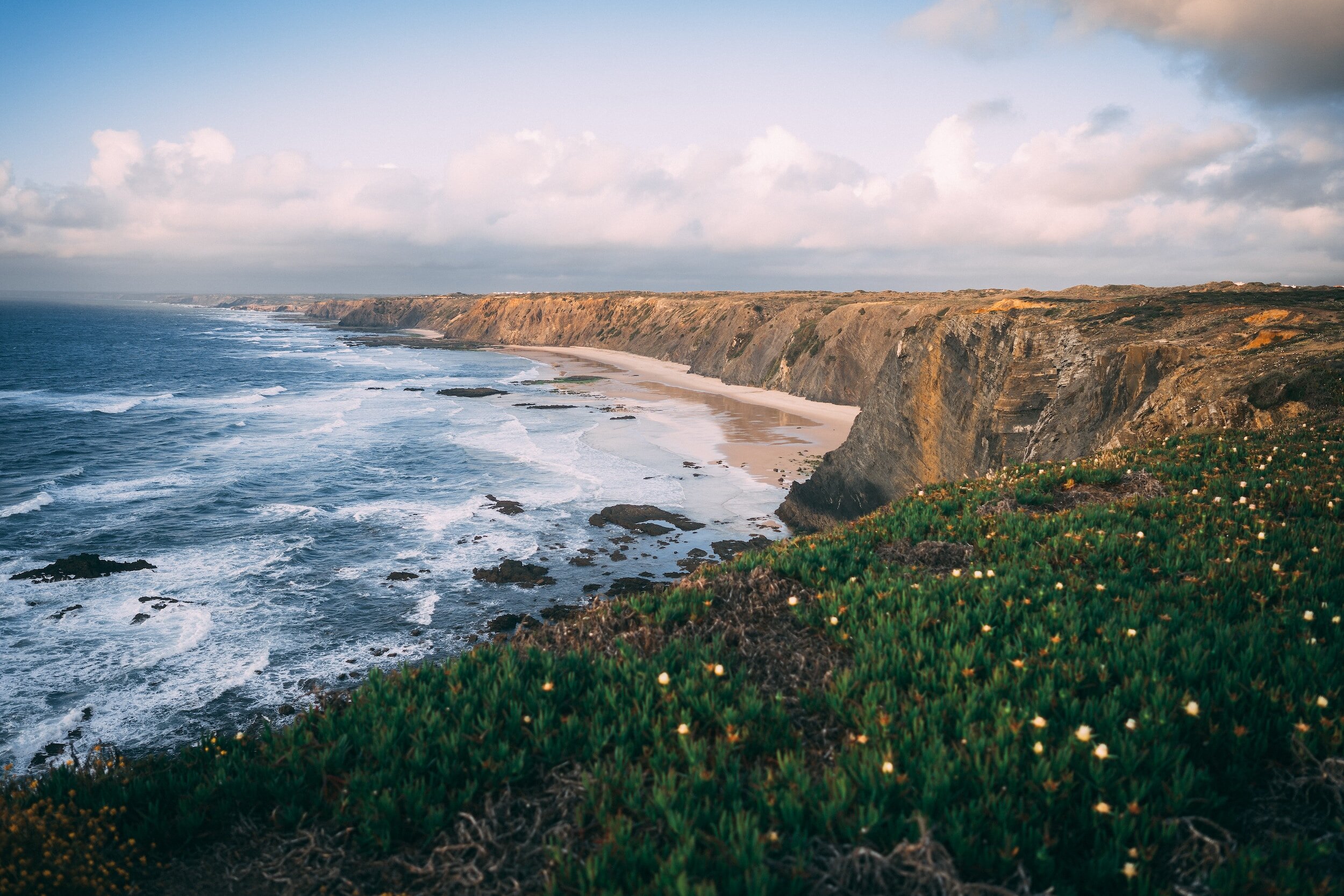A Local’s Guide to Coimbra, Portugal
Affiliate disclosure: some of the links in this article are affiliate links. If you book using one of them, we’ll earn a small commission. All of our info is free to read and free of ads, so we appreciate it!
Known for being home to Portugal's oldest university (and one of the oldest in all of Europe), Coimbra is, first and foremost, a college town. However, it’s also the 6th biggest city in Portugal, with a population of more than 100,000 people, and it has much to offer beyond just university and college haunts.
Seated along the banks of the Mondego river, this is a lovely medieval city with a bustling atmosphere and all the vibrancy that you would expect from somewhere filled with young people. In addition to the University, which is the lifeblood of the city and surrounding region, Coimbra has a charming historic center, crucial historical significance, present-day cultural relevance, and an abundance of tranquil green spaces.
Conveniently located between Lisbon and Porto, it’s also a convenient stopover on any journey between those two cities.
One of the most unique aspects of Coimbra is how the energy in the city changes from one day to the next: during the week, the city is crowded with students and they fill the streets and squares with their energy and excitement.
Then, on the weekends when there are no classes, the city empties out as students return to their hometowns, and it takes on a tranquil, serene air (this is the same during summer break and other annual holidays). This duality is part of what makes Coimbra such an interesting place.
Table of Contents


Where is Coimbra?
Located a bit inland in central Portugal on the banks of the Mondego River, Coimbra is the capital of the Coimbra District and the Coimbra Municipality, and it sits approximately halfway between Lisbon and Porto.
The region surrounding Coimbra has significant geological diversity, but the region's most significant feature is the passage of the Mondego River, the largest river located entirely within Portuguese territory.
Due to its central location, Coimbra is an excellent base from which to reach many other worthwhile destinations in Portugal. Important sights such as Tomar, Fátima, Batalha, and Aveiro are all within an hour, while the Atlantic Ocean is just 40 kilometers west and the mountainous Serra de Estrela park is a little over an hour away.
How to get here
I’ve already explained that Coimbra sits between Lisbon and Porto, but it's worth mentioning that it’s actually roughly 80 kilometers closer to Porto. With that said, regardless of which city you’re coming from, you'll find convenient transportation links, with direct trains and buses available all throughout the day.
Arriving by train
From Lisbon there are more than 20 daily train departures to Coimbra, running between 6 AM and 10 PM. Prices range from €13 to €26, depending on whether you book a high-speed train or slower one (which will make more stops). The high-speed train takes a little under 3 hours, while the slowest train completes the journey in around 4.
From Porto, there are multiple train departures every hour starting from 5:00 AM and continuing until 11:00 PM. The longest journey takes 2.5 hours, while the high-speed Alfa Pendular trains complete the trip in 1.5 hours. Tickets cost from €9 to €20.
Arriving by bus
The train is definitely the more pleasant way to reach Coimbra, but the bus is cheaper and sometimes quicker, so if you’re trying to save money or don’t want to lose time, it can be a good option.
The two main bus companies are Rede Expressos (Portugal's biggest carrier) and FlixBus, which is by far the cheapest option. Between the two companies, buses leave from Lisbon to Coimbra and from Porto to Coimbra a few dozen times per day with tickets costing around from €3-10. Lisbon to Coimbra takes 2.5 hours while it’s just 1.5 hours from Porto.
Arriving by car
If you’re road tripping through Portugal and will have your own car, Coimbra is very easy to reach from just about anywhere. It sits just along the major A1 highway, so driving here is quick, easy, and hassle free. You will take this same road to reach the city whether you’re coming from Lisbon or Porto.
On arrival to the city, unless your accommodation has parking, I would suggest leaving your car at the free parking spots next to the Avenida Marginal and the Parque do Choupalinho. There are also a number of garages in town (in the Baixa section).
To check rental prices and book, I always recommend using DiscoverCars. It's a car rental website that includes offerings from all the major international rental companies as well as lots of smaller local agencies, which often have much better pricing. You can often find great deals.
Why visit
Largo da Portagem square in the Cidade Baixa area
A park running along the Mondego River
Coimbra's city center
I didn't go to college in Coimbra, but that doesn't mean that I don't get inspired by the city's booming college culture. By "college culture," I'm not referring to drunk youngsters acting ridiculously in the streets (although there's that side to Coimbra too), but rather to a much deeper kind of college culture, which is embroidered in every aspect of the city, from its cobbled streets to its medieval buildings and ancient institutions.
The University of Coimbra is at the heart of all things Coimbra, and the town's lovely historic center is still filled with Repúblicas, a type of communal living arrangement for university students that's been a staple of the city for centuries now. Albeit ancient, these Repúblicas are as lively and dynamic as ever, often hosting college parties and cultural events.
Speaking of culture, I recommend visiting Coimbra to learn more about Fado de Coimbra, which is a more relaxed and humorous version of Lisbon Fado, as well as other key aspect of Portuguese culture. For centuries, Coimbra was Portugal's cultural center, and helps to explain why it has been home to so many important monarchs, dignitaries, and artists (especially musicians and poets).
And if all of the above hasn’t convinced you, then let me give you some simpler reasons: Coimbra is a pretty city on the banks of a river, its filled with green spaces, and it's on your way between Lisbon and Porto. It’s also within three hours of many of the country’s other major touristic hotspots. In other words, you’re probably going to pass by at some point anyways, so why not stop in for a visit?
How long to spend
A view over the Cidade Baixa from a viewpoint in the University of Coimbra
In my opinion, a full day in Coimbra is enough time to get a decent introduction to the city. Most of the city's attractions sit very close to one another, so you can arguably even see all the main landmarks in just three to four hours.
However, this is a really nice city and you would not be doing it justice by passing through so quickly. Yes, you could see the principal sights, but you would leave without having gotten any feel for the city itself.
So, my recommendation is to set aside a full day for your visit here, and ideally, to spend the night so that you can experience the buzzing atmosphere in the evening. Remember, this is a city full of students, so the nightlife is pretty great.
With a full day, you’ll have time to explore the downtown area, go on a tour of the university, wander through some of the city’s fantastic green spaces, check out a museum/cultural center, and then catch a Fado show in the evening. It’ll be a busy day, but a very nice one.
Where to stay
The Hotel Astoria in Cidade Baixa
If you plan on staying overnight, the 3 neighborhoods you want to look at are Coimbra Alta (upper Coimbra, near the University), Coimbra Baixa (lower Coimbra on the North side of the river), and Santa Clara on the opposite side of the river and near to the Monastery of Santa Clara.
Quinta das Lagrimas is a 5-star luxury hotel partially housed in a former palace. It has an excellent spa and pool. It’s located in the Santa Clara neighborhood across the river from most of the city’s prime attractions. However, it’s a nice area and it’s a quick walk or cab ride to the historic center. €200.
Sapentia Boutique Hotel offers both regular rooms and apartments in a very open and modern “Scandinavian” style. Lots of exposed wood, white walls, clean lines, and a lovely terrace. Some rooms have river views. €200.
Solar Antigo Luxury Coimbra, in the upper part of the city, is a small, boutique hotel with a design veering somewhere between chic and eccentric. It’s in a great location, some rooms have jacuzzis in them, and a very nice breakfast is delivered direct to your room in the morning. €130.
Hotel Mondego is a very good midrange option in Coimbra Baixa (the lower part of the city). The rooms are bright, airy, and comfortable. €110.
Hotel Astoria is an interesting option for something historic and just in front of the river with really cheap prices. It’s a grand old building from the 1920s with an enormous, classic dining room and big open rooms in Old World style. It needs renovating, but if you can put up with the annoyance of a “quirky” shower, bad-to-no-internet for a night, and not the most amazing bed you’ll ever sleep in, I find it exceedingly charming. €70.


What to see & do
1. See what Baixa (downtown Coimbra) has to offer
Known as "Baixa," which is the Portuguese word for "downtown," this area of the city's historic center is pretty much unmissable as it’s where you’ll experience Coimbra's old-town charm to the fullest. In other words, if you want to see what Coimbra is all about, you need to spend some time downtown.
My favorite spot in the area is Praça 8 de Maio, a bustling pedestrian square with white a marble floor and lovely architecture all around.
If you want to soak in the city's vibe, I recommend that you stop for a beer at the majestic Café Santa Cruz, perhaps the oldest and best-known café in the whole city. Downtown is also known for the Monastery of Santa Cruz, a monumental religious building right next to café of the same name.
And if you get hungry, I strongly recommend that you try the delicious brunch menu at the nearby O Croisant restaurant.
The Baixa area, seen from across the river
2. Go for a tour of the university
Founded in 1290, the University of Coimbra is the oldest in Portugal and it’s more than just the city’s greatest landmark: it is at the heart of the entire region, historically fueling the town's social, cultural, and economic progress.
The two most famous sights here are the Joanina Library and the Botanical Garden, founded in 1728 and 1772, respectively. I know it’s a little bit cheesy, but every time I step foot in one of these places I feel a little bit like I’m in Hogwarts, from the Harry Potter books and movies. The Joanina Library is a Baroque-style building with two-floors of lavishly ornate bookshelves. Calling it stunning would be an understatement and you are certain to hear someone gasp when you walk in. The Botanical Garden is one of the largest greenhouses in Portugal and it features a fantastic bamboo forest.
To make the most of your university tour, I also recommend passing by the Palácio Real, which was the official residency of the first king of Portugal, D. Afonso Henriques, and the Sala dos Atos Grandes, a massive hall with an ambitious name that translates as "The room of Big Gestures."
The Unversity’s courtyard
The second floor of bookshelves in the Joanina Library. Photo: Josep Renalias, CC BY-SA 3.0, via Wikimedia Commons
3. Explore the Quinta das Lágrimas garden
Quinta das Lágrimas means "Estate of Tears," but there's no reason to cry when entering this fairytale-like attraction (unless they’re happy rears, of course)! The “Quinta'“ is actually a famous five-star hotel in Coimbra (with prohibitively high prices), but even if you’re not staying at the hotel, you can visit the gardens.
Built in the 14th century, the grounds here are lovely and you’ll find interesting ruins and ornate fountains, but the garden is best known for its association with one of Coimbra's most celebrated myths: the Legend of Pedro and Inês.
Don Pedro was a Portuguese prince who fell deeply in love with Inês de Castro, his wife’s lady-in-waiting. Their affair was considered scandalous and was of course forbidden, but even so, the two wound up marrying. Pedro’s father, the king, thought Inês’ family sought his throne, so he ordered her killed. The story gets darker from there, and I won’t go into too much detail (you can look it up).
This is probably the most celebrated love story of the entire Portuguese folklore though, and visiting the garden is a neat way to learn more about this legend.
The fountain of tears in the garden. Photo: Vitor Oliveira from Torres Vedras, PORTUGAL, CC BY-SA 2.0, via Wikimedia Commons
4. Stroll through the magical Choupal National Forest
Just outside the city center, Choupal National Forest is the most popular green space in Coimbra and this is where locals go when they’re looking for an escape from the city. It has tons of trails and walking paths, and is perfect for activities such as jogging, birdwatching, or just taking a relaxing stroll.
This 80-hectare forest and green space sitting right next to the Mondego River is characterized by dense, lush vegetation, which means it can get very cold and foggy in the autumn and winter months. During these periods it has a little bit of a spooky atmosphere, which can be fun to experience.
5. Listen to Fado de Coimbra at Casa Fado ao Centro
Going to Coimbra and not seeing at least one Fado de Coimbra show would be like going to Brazil and ignoring Samba. While Fado is traditionally linked to Lisbon, Fado de Coimbra is a subgenre of this mournful music style that can only be authentically heard in this city. Like most things in Coimbra, it's intrinsically linked to the University and college life.
Luckily for you, Fado de Coimbra is still as alive today as it was centuries ago, and the folks at the cultural center Casa Fado ao Centro are known for putting on regular Fado shows. If there's a show when you’re in town, don’t miss it!
Or, if the cultural center doesn’t have anything going on during your visit, you can check out the Fado de Coimbra museum at Torre de Anto, where you can see two Portuguese guitars that were originally played by the late Carlos Paredes, unanimously deemed the best Fado de Coimbra instrumentalist of all time.
Students playing music in Cidade Baixa
6. Visit the Santa Cruz Park and Monastery
When it comes to old religious green spaces, there are few cities richer than Coimbra. The Santa Cruz Park and Monastery is yet another must-see location of this type, perfect for an afternoon stroll and photography lovers.
The area is mainly known for two of its gardens, both featuring beautiful small ornamental buildings initially constructed in the 18th century. The first is the Jardim da Manga, located in the back of the Santa Cruz Monastery, and the other one is the Jardim da Sereia, right at the entrance of the Park.
Right near the university, the park is often filled with students, and in the evenings, it used to be a romantic meet up spot for them (not really anymore though).
Jardim de Manga. Photo: GFreihalter, CC BY-SA 3.0, via Wikimedia Commons
The fountain in the Jardim de Sereia. Photo: Duca696, CC BY-SA 3.0, via Wikimedia Commons
7. Have fun with the kids at Portugal dos Pequenitos and Ciência Viva
If you're traveling with kids, I know that Coimbra's traditional attractions will quickly get a bit boring for them. Fortunately, there are two great places to take your kids here when they’re tired of old architecture and historic places. They’re also fun for grown-ups, so are nice for the whole family.
The first is the Portugal dos Pequenitos, a mini theme park that makes normal people look like real-life Gullivers! The name of the theme park translates as "Portugal of the Little Ones," and there's arguably no Portuguese person under 40 who hasn't visited this one-of-a-kind location during a school trip.
This quirky theme park is like a human-sized dollhouse, and it features miniature versions of popular monuments (the monuments are big enough for people to enter, though).
If Portugal dos Pequenitos doesn't do it for you, take a short trip away from the city center and check out the Ciência Viva de Coimbra center, a modern and interactive museum that makes learning about nature and astronomy a whole lot of fun.
8. Get cultural at CACC and Casa-Museu Miguel Torga
The Centro de Arte Contemporânea de Coimbra (CACC), is a contemporary art museum that hosts modern art exhibitions and events all year-round. The museum is highly regarded and has really put Coimbra on the map in a modern art/culture sense.
Alternatively, should check out the Casa-Museu Miguel Torga, which celebrates another one of the city's most famous historical personalities: the poet Miguel Torga. Known for being one of the most influential Portuguese writers of the 20th century, Torga was born in the small town of Sabrosa, Vila Real, but spent the vast majority of his adult life in Coimbra.
9. Tour the ruins of the Monastery of Santa Clara de Vela
Just across the river from downtown Coimbra sit the ruins of the 14th century Santa Clara de Vela monastery and church, which was initially constructed under the sponsorship of Portugal’s Queen Elizabeth. Having been built in an unfortunate position and too close to the Mondego river, the monastery was the victim of frequent flooding many times over the centuries, and the nuns finally fully abandoned it in the late 1600’s.
Over the years, the monastery fell into total disrepair, and parts of it were consumed by the marsh/wetlands of the nearby river. Starting in the 1990’s, the government started work to excavate the ruins, which were eventually found to be extremely well preserved. The site can now be visited and it’s one of the more interesting ruin complexes in the area.
10. Catch Coimbra’s best views at Penedo da Saudade
Last but not least, I recommend that you pass by the little-known Penedo da Saudade, a romantic site that boasts one of the best scenic views of the city. I actually like going there alone once in a while to enjoy the views in solitude, but it’s definitely more fun in the company of a loved one.
Photo: Joehawkins, CC BY-SA 4.0, via Wikimedia Commons

Restaurants and dining
I'm still trying to find a Portuguese city, small town, or hamlet that doesn't have great food to offer, but I don’t think I ever will! Coimbra is no exception, and the city’s cuisine is surely impressive, especially if you're into codfish and meat served rare enough to be a little intimidating!
Must try local dishes
Chanfana: Marinated goat meat (or sometimes lamb) cooked slowly with garlic, wine, and herbs until tender
Bacalhau à Lagareiro: Salted codfish cooked with olive oil, garlic, and potatoes until the fish is tender and the potatoes are golden and crispy
Leitão à Bairrada: Roast suckling pig seasoned with garlic, salt, and pepper, then slowly roasted until the skin is crispy and the meat is tender
Queijadas de Coimbra: A sweet pastry made with cheese, eggs, sugar, and flour, baked until golden and delicious
Good restaurants
Now that you know what to eat, you need to know where to find these dishes! Well, here are my top four recommendations, going from the priciest (PAPA) to the most affordable (Zé Manel dos Ossos).
PAPA: A sophisticated Mediterranean restaurant with the finest grilled meat in the city and a huge selection of craft beer. PAPA is also known for its world-class desserts (the brownie being my undisputed favorite)
Solar do Bacalhau: A very lowkey mid-range restaurant that serves delicious meat, but is best known for its Bacalhau à Lagareiro
O Telheiro: A Coimbra classic that every local has visited at least once. Their seafood menu is great, but the price-quality ratio is the main reason why this affordable restaurant is perennially full
Zé Manel dos Ossos: Your typical Portuguese traditional restaurant, serving all of the local delicacies for as little as €5 per person
How to spend a day in Coimbra
The University's main courtyard
Start your day with a walk through one of Coimbra's many fabulous green spaces. The Choupal National Forest is my top recommendation, but the Quinta das Lágrimas Garden is just as beautiful.
After a little morning cardio, head back into Coimbra's historic center and grab something to eat/drink at Café Santa Cruz, the classiest and oldest café in the city. Right on the Praça 8 de Maio square, spend a while before or after checking out the architecture, people watching, and visiting the sites, especially the Igreja de Santa Cruz church. Be sure to visit the Jardim de Manga in the back courtyard of the church.
Next, head to the university and join a tour of this world-famous educational institution. The university’s grounds are gorgeous, but the Joanina library and Botanical Garden are the star attractions (for me anyways). Expect to spend a couple of hours touring the sights here.
Whenever you get hungry, I’d suggest a tasty seafood-focused meal at Solar do Bacalhau, which serves Coimbra's best Bacalhau à Lagareiro.
After lunch, if you’re traveling with children, I recommend that you pass by the Portugal dos Pequenitos theme park. Alternatively, you can go for a romantic stroll in Santa Cruz Park and Monastery, which is a tranquil green space and a great spot for some pretty pictures.
As evening approaches, climb up to the Penedo da Saudade viewpoint to catch gorgeous views of the city and river from above.
For dinner, head back downtown and enjoy a more upscale meal at PAPA. Afterwards, stop in at the Casa Fado ao Centro to see if they’re putting on a show that evening. This is by far the best place in Coimbra to catch the city’s unique style of Fado, so it’s a must-visit if they have an event.
If you’re up for a late night, check out some of the bars in the Baixa area and mingle with the locals. With some luck, you can even crash a República party (remember, Repúblicas are communal style college living quarters). If that happens, please follow my advice: no matter what happens, don't try to outdrink the local students!


More Portugal travel info
For more advice on planning your trip to Portugal, have a look at some of our other guides and itineraries!

Connect with a local expert

























